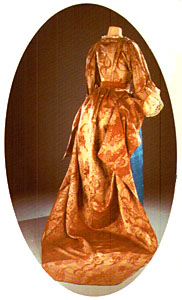


 |
 |
Historic Fashions: Turning the Centuries
As the centuries turn, we look to the past for comparisons of where we
have been and what was worn. The following timeline is from Calendar
2000: Historic Fashions Turning the Centuries.
17th Century Turns...1690 - 1710
Fashion
is the mirror of history. It reflects political, social, and economic
changes, rather than mere whimsy.
Louis XIV, 1690
| 1660 |
England
restores its fashion capital after their Civil War |
| 1690 |
Louis
XIV reigns in France and dictates appearances from his exclusive position |
| 1700 |
European
colonists bring their fashions to North America |
| 1710 |
All
cloth and clothing is made by hand |
|
 |
| Women
make loose fitting gowns called mantuas and are called mantua-makers
Mantua, ca. 1700 silk damask. Royal Ontario Museum |
|
18th Century Turns... 1780 - 1810
| 1780s |
English
simplify their fashions. |
 |
| 1800
White muslin dresses suggestive of classical drapery are the
fashion for women. Average skirt circumference is 104"
of this sheer fabrics made possible by the new spinning and
weaving technology. Chemises, ca. 1800-1807, Museum of
City of New York. |
|
| 1780s |
Rose
Bertin, Marie Antionette's mantuamaker creates elaborate and expensive
creations for the queen contributing to the crown's bankruptcy |
| 1779 |
Samuel
Crompton invents a machine, the "mule", which spins high
quality cotton yarn in large enough quantities for the weavers |
| 1789 |
George
Washington's inauguration in New York City - the capital of the new nation |
| 1789 |
French
Revolution brings a fashion revolution as Frenchmen adopt the simpler,
working class styles. Fashion as an organized industry ceases to exist
in France from 1793-1797 and the professionals flee to other European cities, like London |
| 1794 |
Eli
Whitney patents the cotton gin |
| 1800 |
Textile
production is primarily by machine while clothing is still made by hand |
| 1804 |
Shawls
are the main accessory for the thin muslin dresses. |
| 1810 |
Post
Revolutionary Paris with Napoleon as emperor moves fashion away from
the simplicity of Greek dress to magnificent European style dress
for women. Men maintain their conservative styles |
| 1845 |
Elias
Howe patents the sewing machine |
|
| 1858 |
Charles
Frederick Worth opens his shop in Paris as the first true house of haute couture. |
19th Century Turns... 1890 - 1910
| 1890 |
Clothing
manufacturers tout all of the 'wonderful advancements and improvements'
made possible by abundance of textiles, large American production
labor force, and new cost-saving factory machines |
 |
"Some
dresses are more timeless yet still reflect period aesthetics".
Wedding Dress, 1905, Marjorie Merriweather Post, Hillwood Museum |
|
| 1890 |
Gibson
Girl look popularized by Charles Dana Gibson, American illustrator |
| 1891 |
Simple
tubular skirts and little puff sleeves inspired from early 1800s style is popular |
| 1892 |
Ballooned
sleeves in vogue - an 1830s revival |
| 1896 |
Harper's
Bazar reports that "the huge melon shaped sleeves are absolutely
out of date" and suggests that "the eye becomes accustomed
to whatever is in vogue" |
| 1896 |
Trusty
blue serge suit is the classless "uniform for men" |
| 1897 |
Bicycle
craze….many clothing manufacturers produce clothing for a specific sport |
| 1900 |
Since
the French Revolution male clothing was monotonous with one exception…'sporting
clothes', tennis and outing suits, skeleton coats and vests, flannel
trousers, yachting suits, and bicycle suits |
| 1901 |
Queen
Victoria dies ending the 70 year Victorian Era…Edward VII is crowned
starting the Edwardian Era, the height of sheer femininity in women's dress |
| 1903-1907 |
A
corset shapes women's bodies with an extra long front throwing the
hips, back, and the bust forward
Edwardian Lady is assembled rather than dressed, with jewels, lace, and embroidery.
Paris dominates fashions |
 |
| 1907-1910
More vertical silhouette replaces the S curve shape. Massive
hats with plumes and feathers adorn the heads above the more
tailored day dresses and walking suits. Dresses, 1907-1910,
Missouri Historical Society |
|
| 1902 |
Suits
are very important garments in a woman's wardrobe |
| 1910 |
Edwardian
Era ends with Edward VII's death
Every article of female and male clothing can be purchased ready-made.
Within years, shopping for clothing off the rack becomes customary |
| Why
Study Historic Fashion?
Clothing is culture manifested at the most personal level. By studying
what people wore and why, we gain a fuller knowledge of a specific time and place.
How do we know? Costume historians use primary resources
of extant garments like these featured in the calendar
plus prints, portraits, photographs, letters, diaries, books,
magazines, wills, inventories, and oral histories.
Want to know more? Public and private costume collections
preserve past fashions for current and future knowledge about
the art and science of dress and appearance. Look for their exhibitions
and programs. The
Costume Society of America is an association for the serious
study of dress and appearance. |
Back to Article Archive
Sally Queen & Associates
2801 S. Joyce Street
Arlington, VA 22202
Email : questions@sallyqueenassociates.com
|
![]()